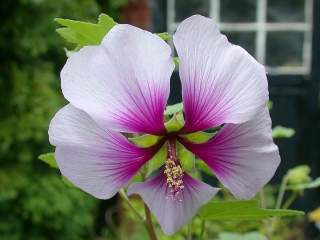 Lavatera aff
maritima 'Bicolor'
Lavatera aff
maritima 'Bicolor'back to section Axolopha
back to Digital Herbarium
more images
The Lavatera Pages
 Lavatera aff
maritima 'Bicolor'
Lavatera aff
maritima 'Bicolor'
Distribution: cultivated form of uncertain origin.
Habitat: dry rocky places, usually near the sea.
Identification: L. 'Bicolor' can be distinguished from most other Lavateras by the reflexed bicolour petals, and from L. acerifolia by its tomentose foliage, etc (L. acerifolia is glabrous). It can be distinguished from the general run of wild L. maritima by the larger flower size, but I am not sufficiently familiar with the last to be able to say how to reliably distinguish the two forms.
Source: Village Greens, a greengrocery shop who also sold a small number of garden plants.
Technical Description
Branched perennial shrub to 50-200 cm, branches stiff. Stems brownish-green, aging to brown, with an indumentum of short hairs, eventually becoming grey and woody; foliage alternate, stipulate, petiolate, petiole green, to 3 cm in length, sparsely haired, stipules green, erect, triangular, 4-6 mm long, laminae sub-orbicular, to 5 cm × 4 cm in size, palmately 5-lobed, 7-9 nerved at the base, base cordate, margin crenate, tomentose on both sides; flowers hermaphrodite, protandrous, involucellate, borne slightly nodding, singly in leaf axils; pedicel 3cm long, shortly hairy, articulated about 5mm below the epicalyx, epicalyx valvate in early aestivation, bracteoles 3, acute, elliptic-lanceolate to ovate, about 10mm long and 5mm wide, and nearly free, calyx valvate in aestivation, sepals 5, 12-15mm long, triangular-ovate, acuminate, connate for about 3/5ths of their length; corolla convolute in aestivation, c. 8 cm in diameter, petals 5, spirally arranged, hypogynous, obovate, retuse, c. 4 cm long, purplish-white with a magenta claw and base, feathered with c. 15 magenta veins; staminal column c. 2 cm, purplish-red, lower half with short white hairs, upper half antheriferous; anthers pink, reniform, unilocular; pollen yellow; ovary 12-loculate, style branches filiform, purple, as many as the locules, stigmas introrsely decurrent, locules uniovulate, ovules ascending, placentation axile; fruit a schizocarp, usually abscissing at the pedicel articulation before maturation, mericarps 12, 5-6 mm long, pale brown, glabrous, angles acute, denticulate; dorsal faces shallowly V-shaped, transversely ridged, lateral faces radially to reticulately ridged, axis large, projecting, conical; seeds mid-brown, reniform.
Description
| L. maritima hort is a soft-branched shrub growing to up to 6 ft in height, but more usually to 3-4 ft. The spread is compable to the height. The stems are a brownish green, aging to brown, with a covering of short hairs, before becoming woody, whereupon they become a pale grey, slightly roughened by sub-parallel lengthways striations. |
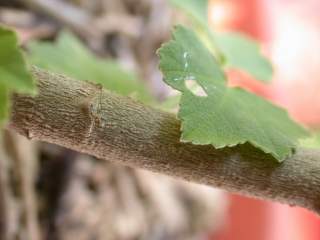 |
|
| The leaves are borne alternately (one per node), subtended by two stipules. They are tomentose, simple, sub-orbicular, palmately 5-lobed and crenate. They are 5 cm wide and 4 cm long. There is little variation in leaf form, but leaves near the base of the plant have rounder and shallower lobes. The petiole is green, up to 3 cm long, and sparsely haired.
|
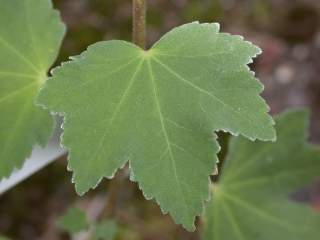 |
|
| The stipules are erect, narrowly triangular, and 4-6mm in length. |
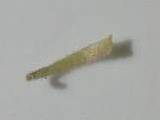 |
|
| The flowers are about 8cm across. They are slightly nodding. They are borne from mid-summer to late autumn. The flower consists of an epicalyx of 3 segments, a calyx of 5 sepals, a corolla of 5 petals, an androecium and a gynoecium. |
 |
|
| The sepals are around 12-15mm long, triangular-ovate, acuminate, and connate for about 3/5ths of their length. The epicalyx segments are acute, elliptic-lanceolate to ovate, about 10mm long and 5mm wide, and nearly free. The pedicel is 3cm long, and covered with short hairs. It bends and thickens about 5mm below the receptacle of the flower. |
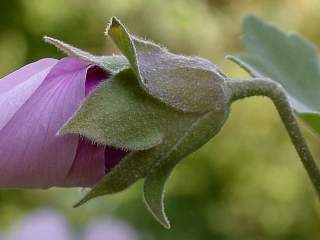 |
|
| The petals are about 4cm long, bilobed, with a cuneate base allowing a view of the underlying sepals, and strongly reflexed. The outer parts of the petals are a pale purple (nearly white), with darker veins. The veins converge and darken to make the base a medium-deep purple. The darker base is less marked on the underside of the petals. The bases of the petals are densely ciliate. |
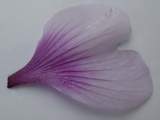 |
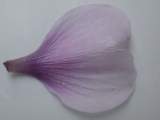 |
The style and stamineal column are purplish red, and about 2cm long, the lower parts of the latter having a covering of short white hairs. The anthers are pink, and the pollen yellow. |
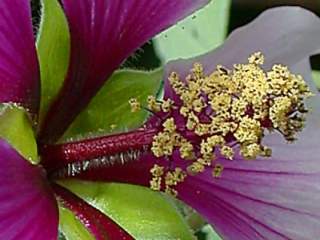 |
|
| The plant does not regularly set seed (see discussion under Taxonomy), the maturing fruit abcissing at the bend in the petiole described above.. Examination of immature schizocarps shows a schizocarp composed of 12 mericarps. They have shallowly V-shaped dorsal faces, and very sharp denticulate angles between the faces. The fruit axis extends beyond the schizocarps as a conical projection. When mature fruits are produced the mericarps are 5-6 mm long, and light brown in colour, with transversely ridged dorsal faces, and radially ridged lateral faces. The seeds are mid-brown in colour, and reniform in shape. |
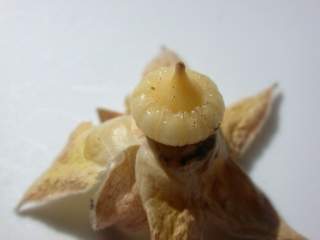 |
|
Variation
None known (vegetatively propagated clone).
Cultivation
L. 'Bicolor' is propagated vegetatively. In my experience hardwood cuttings taken late in mid-autumn do not root reliably (though the use of bottom heating may improve this), and hence I suggest the use of hardwood cuttings in spring and summer.
L. 'Bicolor' is not reliably hardy in cool temperate climates (it is reported as tolerating up to 5°C of frost) and may benefit from a warm sheltered location. It is also intolerant of waterlogging.
Taxonomy
Lavatera maritima Gouan
Malva wigandii (Alefeld) M.F. Ray
Lavatera maritima, in common with other species from Lavatera sections Anthema and Axolopha, is closely related to Malva section Malva, including Malva sylvestris and the weedy mallows. Martin Forbes Ray [1] transfers several of these species, including Lavatera maritima, to Malva. The earliest acceptable epithet that he found was wigandi (Axolopha wigandii Alefeld). However GRIN-Canada says that he was in error, and should have based his new combination of Lavatara africana Cav., Malva africana Miller ex Steudel being only cited in synonymy with another species, and therefore being invalid, and not preemptive of the combination Malva africana for this species. However no-one has yet published this combination. To complicate the matter further INRA says that both Malva maritima Lam. and Malva maritima Salisb. are nomena illegitima and IPNI does not list any other uses of this combination, so it is not clear to me that Malva maritima is preempted either.
Lavatera aff maritima 'Bicolor'
The plant under cultivation under the name of Lavatera maritima appears to be a vegetatively propagated cultivar, probably the same as the cultivar 'Bicolor'. This plant does not set seed under cultivation. Many people believe that it is sterile, and that this is because the plant is a spontaneous polyploid or a hybrid (e.g. maritima × acerifolia). However it could also be due to self-incompatibility. The regular abcission of the maturing fruit is evidence against the failure to set seed being due to the environmental conditions of cultivation.
In addition to it not being self-fertile, I have observed it to be sterile as a seed parent with Lavatera arborea, Lavatera cretica and Malva sylvestris, and as a pollen parent with Lavatera arborea, Lavatera ×clementii, Lavatera cretica, Lavatera mauritanica, Lavatera plebeia, Malva moschata alba and Malva sylvestris. However seed was obtained from a deliberate cross with Lavatera acerfolia, and also from a open-pollinated flower when grown in proximity to Lavatera acerifolia. The reciprocal cross also produced seed. These observations lend weight to the hypothesis that it is self-incompatible, rather than sterile. (Note: although the seeds look to be good I have not yet had the opportunity to attempt to germinate them.)
The plant does not appear to be cross-fertile with 'Princesse de Lignes', but I am not sure that 'Princesse de Lignes' is distinct from 'Bicolor'; I am unable to identify any characteristics with distinguish the two varieties. Unfortunately I have not had the opportunity to attempt to cross 'Bicolor' with wild-type Lavatera maritima.
Synonyms
References
back to section Axolopha
back to Digital Herbarium
more images
The Lavatera Pages
Acknowledgements
text, photographs and HTML © 2002, 2003, 2004, 2005 Stewart Robert Hinsley